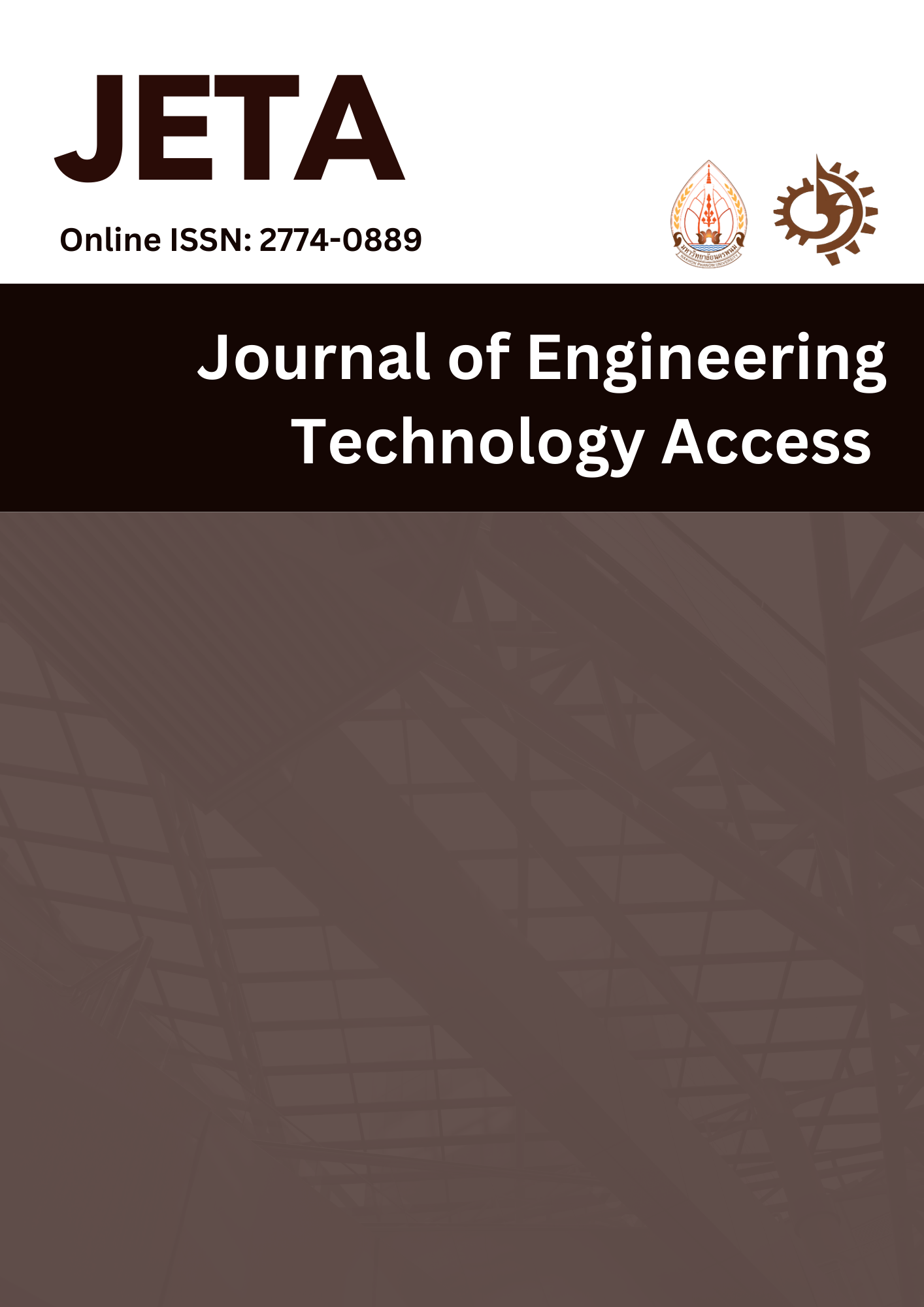การศึกษาปัจจัยในการลดฝุ่นละอองในกระบวนการเผาอิฐมอญแดงด้วยเทคนิคการเผาซ้ำด้วยเตาระบบเปิด
Main Article Content
บทคัดย่อ
การศึกษาปัจจัยในการลดฝุ่นละอองในกระบวนการเผาอิฐมอญแดงด้วยเทคนิคการเผาซ้ำด้วยเตาระบบเปิดโดยทำการออกแบบการทดลองด้วยวิธีการทากูชิ L9 หาปัจจัยที่มีนัยสำคัญทางสถิติโดยใช้การทดสอบค่าความแปรปรวน (Analysis of variance, ANOVA) ปัจจัยในการทดลอง 2ปัจจัย 3ระดับ Wind power (m/s) 10,20และ30 Scrubber distance (cm) 60,70และ80 พบว่าทั้งสองปัจจัยไม่ส่งผลต่อปริมาณฝุ่นละออง PM2.5 อย่างมีนัยสำคัญทางสถิติที่ระดับ 0.05 โดยมีระดับความเชื่อมมั่นทางสถิติ R-Sq = 81.87 %จากการวิเคราะห์ความเหมาะสมสำหรับการลดฝุ่นละออง PM2.5 พบว่า Wind power ที่ 30 m/s และ Scrubber distance ที่ 60 cm. มีปริมาณฝุ่น PM2.5 ต่ำที่สุดที่ 120 μg/m3 นำพารามิเตอร์ที่เหมาะสมแทนค่าในสมการ เพื่อคาดการณ์ปริมาณฝุ่นละออง PM2.5 จากการคาดการด้วยสมการถดถอยมีค่าเท่ากับ 113.37 μg/m3 ซึ่งมีค่าใกล้เคียงกับการทดลองงจริง และจากการคาดการณ์ด้วยวิธีทากูชิของปริมาณฝุ่นละออง PM2.5 มีค่าเท่ากับ 120 μg/m3 พบว่ามีความสอดคล้องกัน
Article Details

อนุญาตภายใต้เงื่อนไข Creative Commons Attribution-NonCommercial-NoDerivatives 4.0 International License.
เอกสารอ้างอิง
Omer, A. M. (2008). Energy, environment, and sustainable development. Renewable and sustainable energy reviews, 12(9), 2265-2300.
Kampa, M., & Castanas, E. (2008). Human health effects of air pollution. Environmental pollution, 151(2), 362-367.
Baes, C. F., Goeller, H. E., Olson, J. S., & Rotty, R. M. (1977). Carbon Dioxide and Climate: The Uncontrolled Experiment: Possibly severe consequences of growing CO2 release from fossil fuels require a much better understanding of the carbon cycle, climate change, and the resulting impacts on the atmosphere. American Scientist, 65(3), 310-320.
Terrenoire, E., Hauglustaine, D. A., Gasser, T., & Penanhoat, O. (2019). The contribution of carbon dioxide emissions from the aviation sector to future climate change. Environmental research letters, 14(8), 084019.
Gheorghe, I. F., & Ion, B. (2011). The effects of air pollutants on vegetation and the role of vegetation in reducing atmospheric pollution. The impact of air pollution on health, economy, environment and agricultural sources, 29, 241-80.
Chantara, S., Sillapapiromsuk, S., & Wiriya, W. (2012). Atmospheric pollutants in Chiang Mai (Thailand) over a five-year period (2005–2009), their possible sources and relation to air mass movement. Atmospheric Environment, 60, 88-98.
Visut Asanavijit , Panich Intra, Anukul Pansa. (2019). Development and Efficiency Evaluation of an Electrostatic Collector for Smoke Removal from the In-House Cooking ProcessThai Science and Technology Journal, 566-587.
Weera Punin. (2018). A study on the efficiency of dust removal using a wet air scrubber treatment system on a local community rice mill. Industry Technology Lampang Rajabhat University, 11(1), 61-73.
Namkaew, S., & Prasomthong, S. (2021). Application of Taguchi Method for Burnishing Process of AA5052 Aluminum Alloy by Studying the Optimization of Production. The Journal of Industrial Technology, 17(1), 82-94.
Armesto, L., Bahillo, A., Veijonen, K., Cabanillas, A., & Otero, J. (2002). Combustion behaviour of rice husk in a bubbling fluidised bed. Biomass and Bioenergy, 23(3), 171-179.
Pavlov, A. A., Kasting, J. F., Brown, L. L., Rages, K. A., & Freedman, R. (2000). Greenhouse warming by CH4 in the atmosphere of early Earth. Journal of Geophysical Research: Planets, 105(E5), 11981-11990.
Giunta, M. (2020). Assessment of the impact of Co, NOx and PM10 on air quality during road construction and operation phases. Sustainability, 12(24), 10549.
Department of Pollution Control Report on the pollution situation in Thailand 2000-2015.






